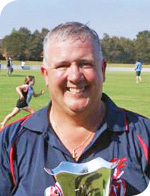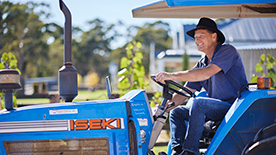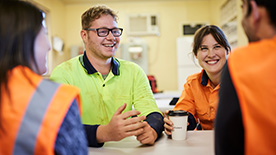Return to work coordinator profile - Darren Webb

Name: Darren Webb (aka Spider)
Position: Transport Supervisor – SA
Organisation: I work for Elgas, a large company with locations throughout Australia. Here in South Australia we have approximately 25 admin and sales staff, 10 people refilling cylinders (from BBQ sized bottles to domestic bottles), 8 bulk vehicle drivers and 12 cylinder vehicle drivers. We also have depots in Mildura, Berri and Broken Hill with around another 30 personnel.
Can you tell us about your previous work injury which helped shape the way that you carry out your role as a return to work coordinator?
In July 2017, whilst out conducting training with a new driver, I connected the fill hose from the tanker to a domestic bottle. When I opened the gun, the gun separated from the bottle, throwing me to the ground, fighting the hose and trying to close off the gun. I couldn’t immediately see any signs of being burnt on my skin but commenced our first aid protocols for cold burns.
As the name would suggest, a cold burn results from exposure to extreme cold rather than extreme heat and needs to be treated differently. Tepid water should be applied to the area, rather that cold water, to bring the affected area back to normal temperature, rather than cooling the area as you would with a hot burn.
We immediately drove to the Lyell McEwin hospital after the initial first aid treatment (tepid shower). I had my injuries covered in sterile dressings, was given analgesics and discharged, having to report to the Royal Adelaide Hospital Emergency Department the following morning for surgery and a possible skin graft.
The wounds were abraded whilst I was under general anaesthetic and bio-braid dressings were applied to the worst of the wounds on the upper right arm. Luckily a skin graft wasn’t required.
Three days after the operation I was discharged from hospital but had to attend the Burns unit weekly to have the bio-braid and wounds checked. I was also put on antibiotics to ensure that I did not get an infection. I was not allowed to return to work, normally a desk position, until the wounds had healed completely to ensure that I was not exposed to any possible source of infection.
After two weeks at home, I finally had the last of the bio-braid removed and was allowed to return to work a week later.
Luckily for me, I am a pretty quick healer, and whilst initially the blistering was quite bad, I did not require a skin graft and have completely recovered with only some discolouration on my skin on my upper arm.
I heard that your experience had quite the impact on the way that Elgas managed these types of injuries. Can you tell us how your injury experience contributed to your current safety and return to work practices?
My belief is that no accident is good, but you should always take the opportunity to learn from them. After this incident, I realised that many people don’t know how to treat a cold burn. We are all taught how to treat a regular burn, but a cold burn is different. Rather than heating the skin/tissue in a regular burn, a cold burn freezes the skin and tissue, so you need to get the area back up to normal body temperature as soon as possible by applying tepid water. As sensitivity is lost to the area, hot water should not be used as there is the possibility of causing a hot burn. If you use cold water, you risk hyperthermia. We also realised that our first aid kits in all of our vehicles held burn kits, but they were not appropriate for treating cold burns.
All of our vehicles now carry a minimum of 2 litres of water in bottles that can be used for the treatment of cold burns.
We also now have ‘tear down’ guides in our vehicles and at our fill points so that if something does happen, we can tear down the treatment material and give it to the first aiders/responders.
How has your own experience with work injury contributed to the way you undertake the return to work coordinator role?
It has made me understand some of the frustrations that workers and coordinators can have – whether it be because workers want to get back to work as soon as possible, or to understand the process that has to be followed and why. Having been in both positions, I believe it gives me some credibility as a return to work coordinator. But I, like most, can still feel some frustration when things are not going as expected – but we have to remember that we are all individuals and recover in different ways and at different speeds.
Can you tell us about your role as Transport Supervisor for Elgas, and how this has benefited and/or presented challenges that you have had to overcome in order to undertake the Return to Work Coordinator role for Elgas?
Most of my time is taken up with compliance issues. These can come in various guises, but daily I undertake basic fatigue management for all of our drivers to ensure that they are only driving to their hours and taking their appropriate breaks. I also look at all of our vehicles’ pre-journey inspections to ensure that they are defect free. If a vehicle has a defect, I decide whether it needs to be taken out of service and have repairs immediately. If it is a minor defect, I clear the vehicle and organise for repairs at its next service. I also assist if we have any breakdowns.
The other major part of my job here is training. This includes training new bulk drivers, cylinder drivers and cylinder fillers/testers to ensure that they can do the job safely and correctly. At the end of their training I conduct assessments to ensure that they are fully compliant with our policies and procedure as well as those of the Regulator and authorities.
I also go out with the drivers to spend the day with them, talk to them, find out any issues and most importantly, keep the lines of communication and safety open at all times.
Whilst being a return to work coordinator is not my full time position, I still have a keen interest in the role because I like to help my colleagues where I can. It also makes it easier for our staff and management to have someone locally looking after our people rather someone from another State who may not know the person, situation or working conditions.
What advice would you give to other return to work coordinators?
Just remember, everyone is different. Take the time to get to know the person who is injured, their supervisor and the work place. There is no reason to rush, so take your time. We are not perfect, and we may get things wrong sometimes, but we are human, and as long as we learn from our mistakes, all is good. Finally, you have a great network of other coordinators out there, so use them, they are your greatest resource.
Thank you for your time Darren, and sharing your personal story with us!






 Date printed: 23 Jul 2024
Date printed: 23 Jul 2024

